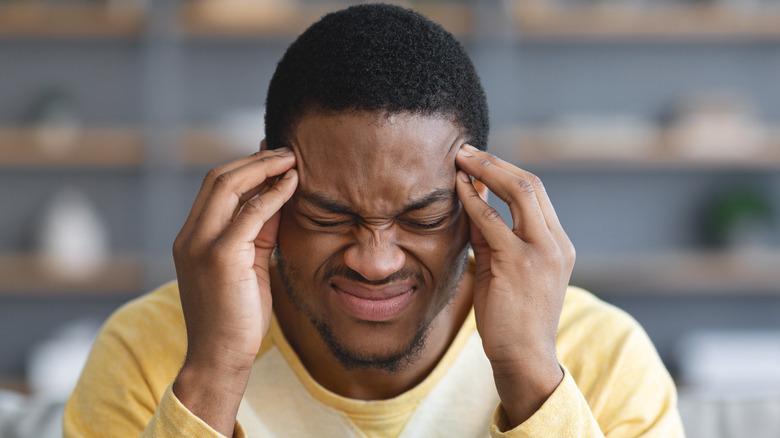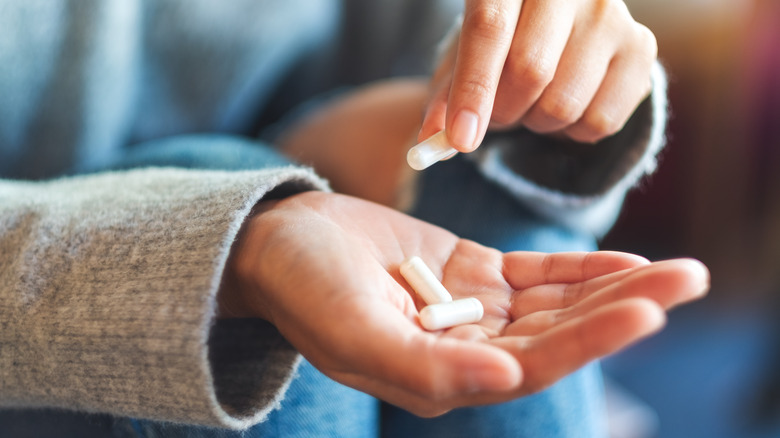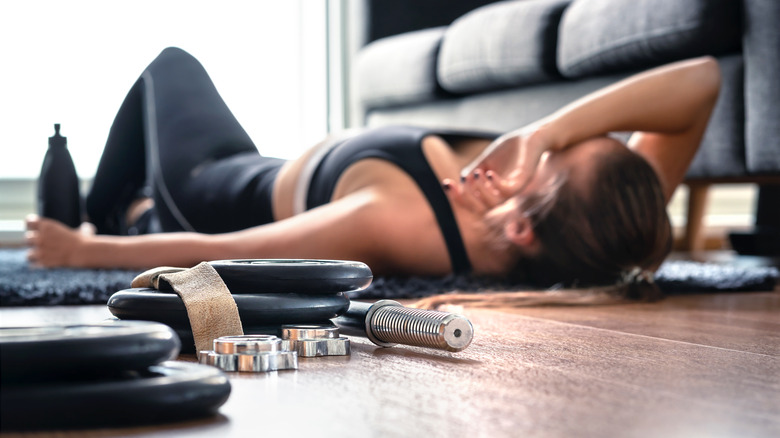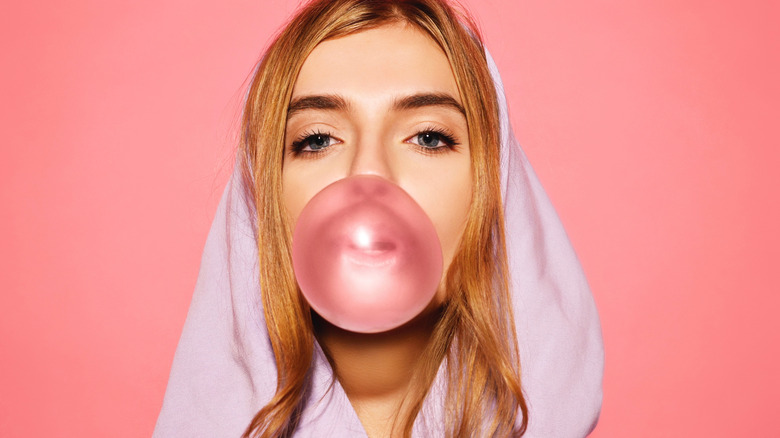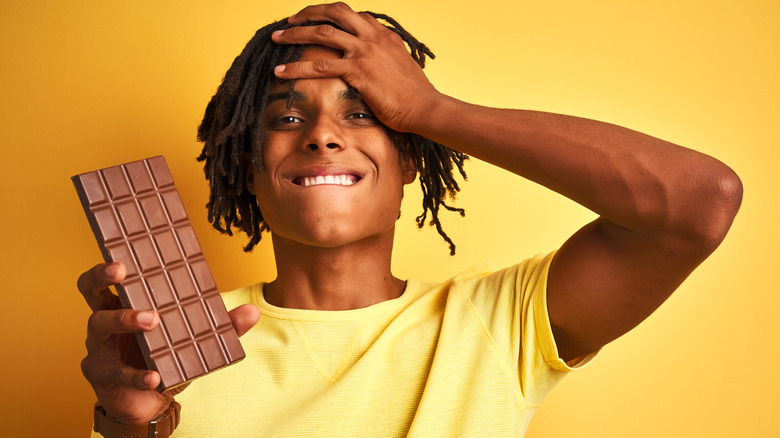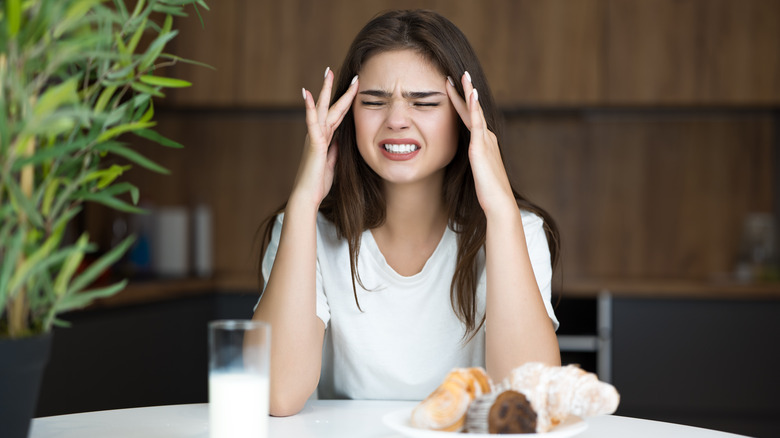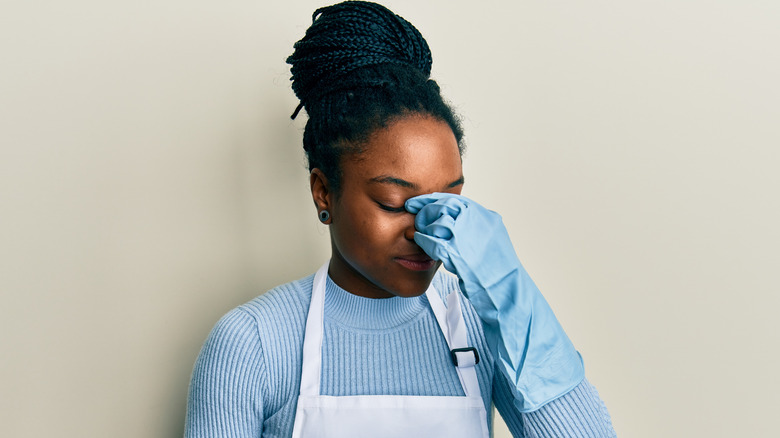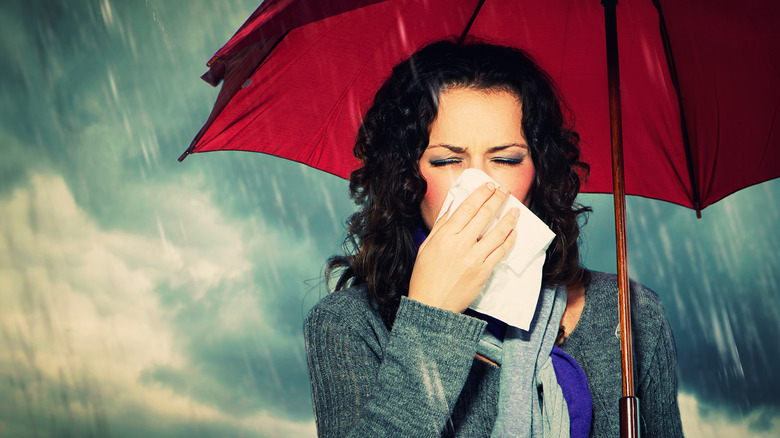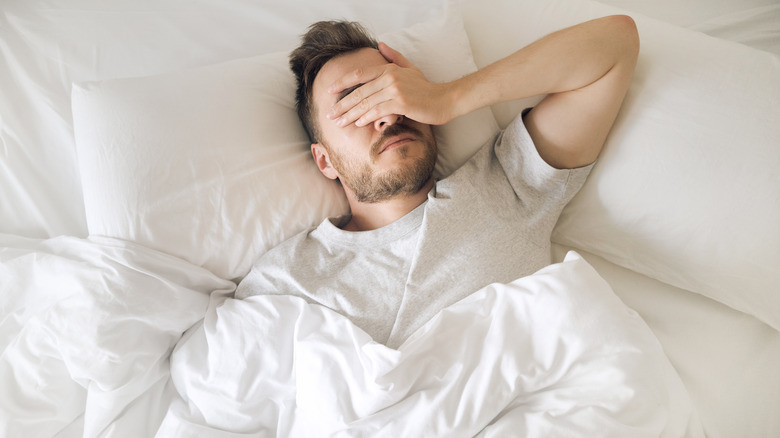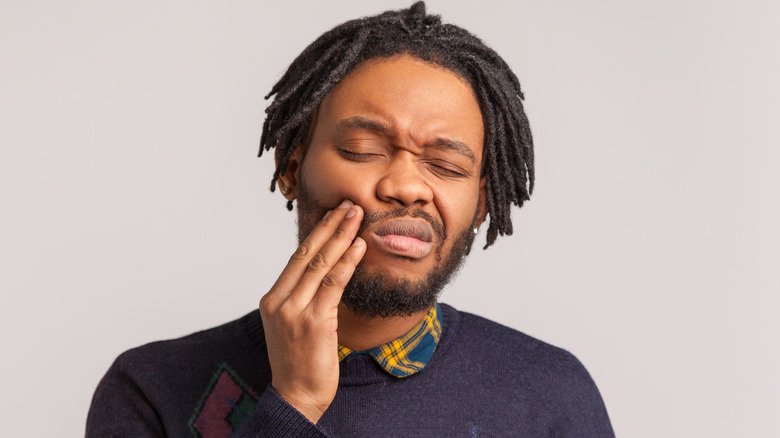Surprising Things You Might Not Know Are Linked To Migraines
Getting a migraine can be pretty soul-crushing business. It usually manifests as a staggering headache but ultimately presents differently for everyone, varying in frequency and intensity (via Nature Reviews Neurology). Some people experience it as a pulsating pain on one side of the head or both, which may be accompanied by a range of symptoms such as nausea and vomiting. One-third of migraineurs experience an "aura," either before or during the pain sets in, which is typically a sensory input like a flashing light, shimmering zig-zag lines, or pins and needles in the body. This beast of a condition can be hard to tame, veering towards disabling at times. Sufferers sometimes find themselves unable to continue functioning in everyday activities, which is why it can be helpful to identify what precedes an attack in order to have a safety net in place.
So, what is exactly is happening to your body when you get a migraine? Well, the research is continually expanding (via Nature). Doctors and scientists have highlighted a vast spectrum of possible factors that can contribute to the development of a migraine, ranging from physiological to dietary to environmental and emotional. Many of the underlying causes, such as stress, dehydration, or bright lights, are fairly well-known, whereas others may boggle your mind. Here are a few surprising things that could be setting off your migraines, according to researchers.
Alcohol
The Greek philosopher Celsus once wrote: "The pain ... is contracted ... by drinking wine" (via The Journal of Headache and Pain). Alcohol's status as a migraine trigger has been recognized for centuries and is still widely investigated today. According to a 2018 study, 35.6% of migraine patients reported alcohol consumption as the main initiator of an attack. One-third of patients found that their migraines started within three hours of knocking back a drink, and nearly 90% experienced an onset within 10 hours of a beverage passing their lips, irrespective of the type of alcohol it was. However, wine may be especially problematic; nearly 78% of people said vino was a trigger.
Several studies have identified wine as a primary culprit (via The Journal of Headache and Pain). This is often chalked up to the various compounds it contains, such as histamine — which is more abundant in red wine than white. A headache is a common symptom of histamine intolerance, where people are lacking the enzyme needed to break down histamine. Alcohol is also said to release histamine from the body's tissue mast cells. Other components of wine that are deemed potentially problematic include sulfites, flavonoid phenols, and phenylethylamines.
However, research on the link between alcohol and headaches has yielded mixed findings. Some studies suggest that the role of alcohol has been overestimated. "The fact that few headache patients cannot tolerate some alcoholic drinks does not justify the consideration that alcohol is a major trigger," wrote researchers in The Journal of Headache and Pain.
Medications
Medication can be a double-edged sword. It can help beat the excruciating symptoms of a migraine, but it can also backfire with frequent use, making your headaches even worse, a study in Therapeutic Advances in Drug Safety showed. "Medication-overuse [headaches]" occur when migraine drugs, such as ergots, narcotics, triptans, and analgesics, are taken habitually or excessively by migraine sufferers. This sets off a vicious cycle in which people take more and more medication in an attempt to ease the symptoms of their primary headache, but the number of headaches they have increases, until it becomes a daily or near-daily condition. A medication-overuse headache is defined by the ICHD-II as occurring on 15 or more days per month.
A study from the journal Neurology looked at a two-month period in which patients experiencing medication-overuse headaches suddenly stopped using their migraine medications. The researchers found that 64% of the subjects stayed drug-free — of which, 45% got better, 48% saw no change, and 7% continued experiencing more headaches. The study demonstrates that eliminating these medications can often be an effective treatment of medication-overuse headaches.
Exercise
If you're noticing that your gym workouts are often followed by a brain-splitting headache, you may be on to something. Some researchers have discovered that intense physical exercise is a common trigger of head pain among migraineurs. A 2013 study published in The Journal of Headache and Pain highlighted that exercise-induced migraine attacks occurred in roughly 38% of migraine sufferers, half of whom quit their sport-of-choice as a result. Neck pain was usually the principal symptom that emerged in migraineurs. One possible explanation offered up by the study authors is that intense workouts may affect sleep quality, which could be the underlying pathophysiological mechanism at play. Exercise can also elevate your heart rate and blood pressure and churn out higher levels of brain lactate, all of which have the potential to ignite an explosive migraine headache.
Exercise is a well-known remedy for various health issues, which may be why many people often overlook this migraine trigger. A 2018 study showed that while "exercise headaches" are a real phenomenon, regular aerobic exercise could also have a "prophylactic effect" on the frequency of migraines. In other words, an appropriately devised workout program may have positive therapeutic outcomes for migraine sufferers: Specifically, it could reduce the frequency and intensity of their headaches due to the positive impact of exercise on sleep, weight, and mental and physical wellbeing.
Chewing gum
Chewing gum has its upsides — stress relief, plaque reduction, fresher breath. But according to a 2014 study in the journal Pediatric Neurology, this common habit is also a rarely-mentioned yet common initiator of migraines. The researchers specifically looked at older children and teenagers who chewed gum on a daily basis and they found that nearly 87% of participants who stopped chewing gum saw their migraine symptoms either diminish or go away entirely, whereas those who picked the habit back up again experienced rebound headaches within just a few days.
Some studies have attributed the relationship between gum-chewing and head pain to temporomandibular disorders (TMDs). When people chew gum excessively, the jaw muscles get an intense workout, which can lead to jaw, neck, and head spasms. Over time, this can result in discomfort and even trauma in the temporomandibular joints, which are situated at either side of our heads, connecting the jaw and skull (via Johns Hopkins Medicine).
Cheese
Cheese lovers aren't going to like this next piece of information. Foods are reported as the main cause of migraines by roughly 20% of sufferers, according to a study in Nutrients. And numerous studies, including one in the journal Headache, point towards cheese as a common culprit behind migraines. That's not to say that a dollop of brie or a slab of camembert will necessarily cause a flare-up in everyone, but aged and fermented foods like cheese are high in tyramine, an amino acid that can lead to head pain in some people (via ScienceDirect). Too much tyramine can cause vasoconstriction (narrowing of blood vessels) and subsequent rebound vasodilatation (dilation of blood vessels) facilitating a chain of bodily reactions that trigger headaches in migraine sufferers. It's suggested that many migraineurs are deficient in monoamine oxidase (MAO), an enzyme in the gut that's responsible for breaking down tyramine from foods (via Pediatric Neurology).
An explanation for the tyramine-migraine relationship is that tyramine sends a signal to your brain's nerve cells to produce norepinephrine — a hormone and neurotransmitter that drives up your heart rate and blood pressure, winding up with a migraine attack, per a 2020 study from the Journal of Medical Investigation and Practice.
Chocolate
"The concept of dietary migraine ... has been with us for more than 200 years," wrote the authors of a study in The Journal of Headache and Pain. Researchers have frequently pinpointed chocolate as a migraine trigger due to its abundance of unique compounds like biogenic amines, known to influence health. This yummy food contains the vasoactive amine phenylethylamine, which readily crosses the blood-brain barrier, making us feel more alert and instigating migraine attacks. Methylxanthine is another chemical in cocoa that can provoke the onset of a headache, which has a stimulant-like effect similar to caffeine.
However, it is also possible that chocolate can have a beneficial impact on migraines, suggests a 2020 study from the journal Nutrients. Cocoa has ample vitamins and minerals like riboflavin and magnesium, which could be used as preventative supplements for migraineurs. A 2019 study published in Neurological Sciences found that consuming more tryptophan, which is abundant in chocolate, lowered people's odds of getting a migraine by 54% to 60%. This is because tryptophan boosts serotonin — a "happy" chemical that migraineurs tend to have decreased levels of.
Fasting
Several studies have implicated fasting or skipping meals as major precipitants of migraine attacks. It's estimated that 25% of children and 40% of adults experience fasting-induced migraine, according to a study in the Journal of Pain Research. This type of headache usually occurs when people refrain from eating for 16 hours or more, but their symptoms often go away soon after they start eating again (via Verywell Health).
An explanation for the onset of fasting-induced migraines is that people may experience a drop in blood sugar due to eating fewer calories, which influences the brain's pain receptors, noted a study from the journal Current Pain and Headache Reports. But this hypothesis has been challenged, since headaches crop up even when blood sugar readings are normal, per Verywell Health. Another theory is that fasting increases the production of stress hormones (via Journal of Pain Research). For instance, norepinephrine is a fat-burning chemical that's released into the blood when the brain perceives a stressful or threatening situation, details a study from the American Journal of Clinical Nutrition.
Some researchers speculate whether people who are more susceptible to headaches in general are simply more likely to get a fasting headache (via Current Pain and Headache Reports). In truth, the specific mechanisms behind developing a fasting-induced migraine aren't yet entirely clear.
Strong or unsual odors
People with migraines often report being triggered by a strong or odd smell. Migraineurs exhibit hypersensitivity to myriad scents in general, ranging from perfumes to foods to cigarette smoke, and up to 50% of sufferers report regularly experiencing odor-triggered migraines, according to a study in Current Opinion in Neurology. Additionally, a 2017 study published in Preventive Medicine Reports found that 33% of Australians experience health issues when exposed to fragranced consumer products like air fresheners, cleaning supplies, and personal care products — 10% of whom suffer from migraines. It is suggested that it isn't necessarily the scent itself but rather the various volatile chemicals that these products release, including terpenes, which are air pollutants that interact with ozone to form carcinogenic compounds like formaldehyde and acetaldehyde, a report in Atmospheric Environment explained.
Researchers have pointed out that migraineurs tend to be more sensitive and intolerant towards certain smells during attacks — a phenomenon referred to as "osmophobia." An explanation for this is that individuals undergo greater activation in specific olfactory and pain receptors in the brain (via Current Opinion in Neurology). During a PET scan of migraineurs, for example, heightened activity was observed in the left temporal lobe when there was odor hypersensitivity.
Weather
The weather's effect on our health and mood frequently slips into conversation. And scientific studies show that changes in weather — including the onset of a typhoon or rainstorm or shifts in temperature — can contribute to migraine episodes approximately 20% of the time. One Japanese study investigated the link between atmospheric pressure changes and the likelihood of developing a migraine, and found that when the barometric pressure dropped, migraine symptoms generally worsened, but when the pressure increased, symptoms appeared to improve. Another study found that migraine patients were susceptible to multiple weather variables; an individual's risk of a headache shot up on the days before a strong and warm "chinook" wind kicked in, as well as on days that winds blew more than 23 miles an hour.
It's not yet fully understood why weather changes serve as a perfect storm for headaches, but researchers have put forward some interesting ideas. It's been proposed that barometric temperature changes are tied to headaches because they cause your blood vessels to compress and dilate, resulting in abnormal blood flow. These changes can also affect the air pressure within your sinus cavities — a bit like when you're in an airplane and your ears pop (via Healthline). What's more, a rise in humidity creates more mucus in your nasal cavities which acts as a protective mechanism against pollutants and allergens, and over time, this can add up to congestion, which commonly precedes headaches (via The Conversation).
Female hormones
Many women are probably unaware that their hormones are a common offender when it comes to developing a migraine. Yet, more than 50% of women reported experiencing a debilitating headache during menstruation, according to a 2012 study from The Journal of Headache and Pain. A hormonal imbalance occurring throughout the menstrual cycle is thought to be a precipitating factor (via Rush).
Estrogen levels generally spike when women ovulate and the subsequent drop can cause the blood vessels to contract, which may lead to a migraine attack. Headaches might also stem from the fact that low estrogen levels can make the nerves in your face and scalp more susceptible to pain (via Science Alert). Some women are given hormonal birth control to stabilize their estrogen levels, and while this can be helpful in some situations, it doesn't come without its side effects and risks, warns the American Migraine Foundation. For example, the use of oral contraceptives pills can raise the risk of a stroke and cardiovascular disease in migraineurs, while estrogen-based oral contraceptives drive up the risk of deep vein thrombosis in women with a family history of blood clots.
On the other hand, a 2015 study from The Journal of Headache and Pain found that many women report an improvement in migraine symptoms during all three trimesters of their pregnancy, which is when estrogen levels soar and progesterone levels plummet, only to rise again at the end of pregnancy.
Too much sleep
The idea that a lack of shuteye can bring on a migraine seems almost intuitive — and there's plenty of science to back this up (via WebMD). But less expectedly, researchers have observed that getting too much sleep can also spark a migraine attack (via International Journal of Molecular Sciences). The "weekend migraine" occurs when people find themselves struggling with a migraine due to oversleeping — this typically occurs on the weekend or on vacation, hence the name of this type of headache.
One explanation for this effect is that oversleeping disrupts your circadian rhythm, causing a secondary effect on your brain's production of the neurotransmitter serotonin — the chemical that regulates your natural sleep-wake cycle (via Healthline). Oversleeping might also mean that you're skipping breakfast or being deprived of water, and being hungry or dehydrated are possible contributing factors to those nasty headaches. While oversleeping on occasion isn't necessarily going to kick start a migraine, excessive sleep could certainly pose a problem for migraineurs if it became a daily occurrence. A healthy dose of sleep for adults is somewhere between seven to eight hours a night, recommends the National Sleep Foundation.
Bite misalignment
It turns out that the way you bite, also known as occlusion, can play a consistent role in migraine pathophysiology (via Journal of Prolotherapy). In particular, a misaligned bite can set off a domino effect by causing you to clench your jaw, which then aggravates your nerves and strains the muscles on the side of your head, namely your temporomandibular joints. The tension that it creates usually travels to other areas of your upper body, causing a stiff neck, shoulder pain, and of course a throbbing headache.
Over time, bite problems can give rise to temporomandibular disorder (TMD), according to a study in the Journal of Physical Therapy Science. A 2019 study from the Journal of Pain revealed a strong association between TMD and migraines, while earlier research found that the relationship between the two might be mutual, in that TMD can result in headaches, and headaches can worsen TMD pain (via Pain Research and Management). One way to determine if TMD is triggering or exacerbating your migraines is to keep an eye on whether chewing activity tends to bring about a headache, per the American Migraine Foundation.
Poor posture
Not everyone is aware that their posture could be contributing to their migraine woes. Some researchers suggest that poor posture, such as bending your neck towards the chest for a prolonged period of time, can result in muscle strain, stiffness, and weakness, gradually building up to a migraine attack. A 2017 study from the journal Cephalalgia lent support to this notion, investigating the association between musculoskeletal dysfunctions and migraines. The researchers discovered that people who were struck by regular migraines also happened to be more susceptible to musculoskeletal impairments. Their explanation for this was that frequent headaches can cause some tension in the neck, shoulders, and head, in turn, resulting in joint dysfunctions, while preexisting joint or muscle pain can exacerbate headaches and bring on migraine attacks.
If you think that your posture may be at the root of your migraines, it might be worth scheduling an appointment with a physical therapist or chiropractor. It's also suggested that people struggling with this type of condition generally avoid sitting or standing in one stagnant position for a prolonged period of time but regularly change their position, as well as support their lower back (via NHS).
